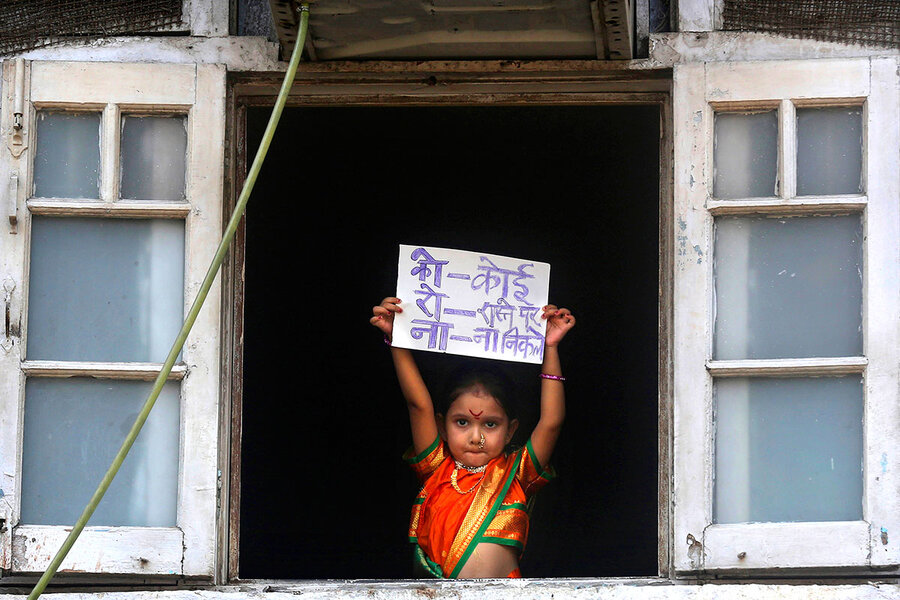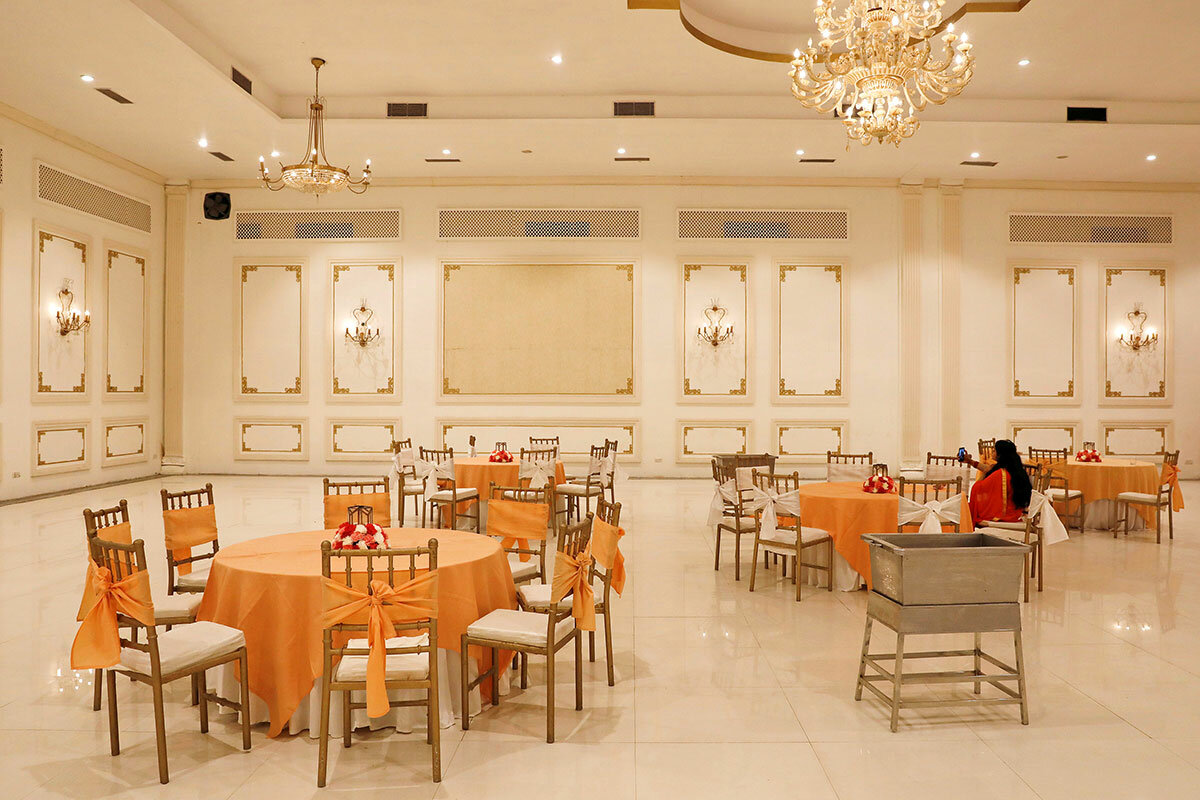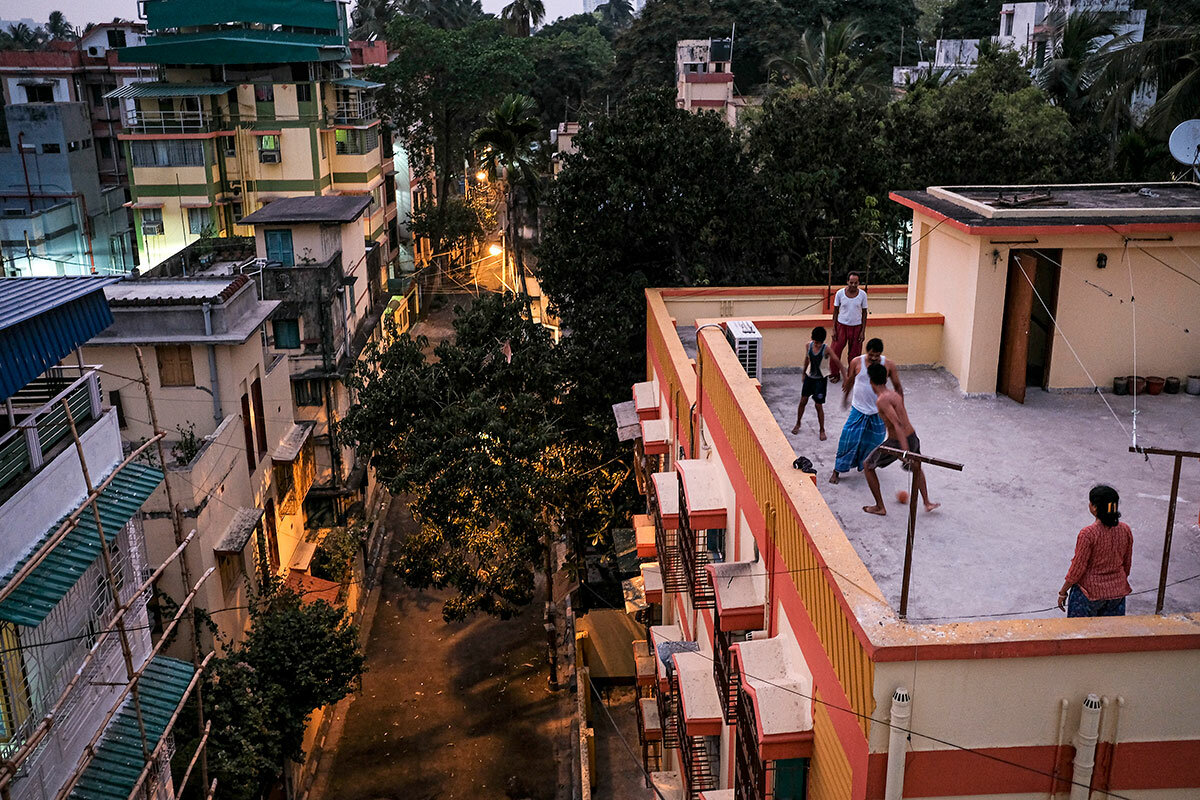India’s lockdown: Where community is prized, isolation proves tough
Loading...
| New Delhi
When Minhal Hasan and Kritika Gupta got married last month, it wasn’t what they’d pictured.
The couple, who both work for a production company in Delhi, planned on bringing all their family and friends and co-workers together for a grand celebration with hundreds of people, spread out over two days. Instead, a week before the March 20 ceremony, they were sending frantic texts and emails to disinvite their guests, and wound up hosting a pared-down lunch for 20 in their home. There was no hugging or touching. Sanitizer was handed out to each guest. Their wedding costumes went to waste.
“We had to improvise our wedding and ended up having a good time. But after this is over, we will celebrate with everyone,” says Mr. Hasan.
Why We Wrote This
On a normal morning in Delhi, “I start hearing the vegetable vendor, the fruit seller ... shouting out their wares,” this writer told us. “I know [my neighbors’] rhythms: who goes for a morning walk, who goes to the temple. It’s the background noise to life in India” – but not for now.
Indian weddings, known for being long-drawn-out and extravagant, are just the latest casualty of the coronavirus outbreak, which has halted all forms of community life. Since March 24, when the government announced a 21-day lockdown, Indians have experienced everyday life in a way that is completely at odds with what they are used to. Noisy streets have become eerily quiet, overcrowded buses and trains have stopped running, bustling markets have shut down, politics and protests have been suspended, and the collective hubbub of conversation has died out. Hundreds of millions of workers are confronting severe challenges to make ends meet.
All around the world, people are attempting to keep interactions to a minimum. But the idea of social distancing comes with added challenges here, where, for many, it is not just a physical impossibility, but incompatible with their identity – a culture where interdependence within families and communities is both useful and prized. Some 60% of rural Indian households, and 30% of urban ones, are multigenerational, according to a report by the Intergenerational Longevity Centre.
Editor’s note: As a public service, all our coronavirus coverage is free. No paywall.
There is no word for “social distancing” in most Indian languages. When Prime Minister Narendra Modi addressed the nation to announce the lockdown, he spoke in Hindi, but had to borrow the term from English.
“The idea of self-isolation is a difficult one for Indians to grasp or implement,” says social commentator, columnist, and author Santosh Desai. “There is a compulsive need in us to gather energy from the collective; we find comfort in it. Being an individual is a daunting task, and in India where we’ve always had large families, it leads to a lot of anxiety.”
It’s no coincidence, he points out, that two of the greatest Indian epics, “Ramayana” and “Mahabharata,” are about the pain of exile, as the central characters are separated and eventually reunited with their social groups. In fact, as soon as the lockdown began, the state broadcaster said it would rerun hugely popular series from the 1980s and ’90s based on the two epics – announced with the hashtag #IndiaFightsCorona.
A challenge – and a strength
One day into the lockdown, Shweta Keerthi Sethia, an event planner in Delhi, got on a Zoom video call with her family in the city of Hyderabad, nearly 1,000 miles away. It was Ugadi, a harvest festival of southern India.
Typically, extended family and friends gather to pray and have an elaborate meal with dishes made of mango to signal the arrival of summer. Preparation begins days in advance as new clothes are bought, homes are decorated with mango leaves, and visitors keep dropping in, but not this time. “It was so low-key. I can’t ever remember it being like this,” Ms. Keerthi Sethia says.
Indians, already the biggest users of WhatsApp in the world, are moving their communication to Zoom, now the most downloaded app in the country. But they’re still managing to connect in real life, too.
Like citizens of all cities in these unusual times, Indians have been congregating and connecting on balconies, windows, and rooftops. Millions came out to clap and clang their kitchenware on March 22 to express gratitude for essential service providers. In one Delhi neighborhood, residents played the popular Bingo-like game tambola across balconies, and in the western city of Ahmedabad, the festival of Chaitra Navratri had people dancing the garba folk dance on balconies. It helps that Indian neighborhoods are dense and packed; even those who can afford privacy often prefer to live in houses where they can interact with their neighbors, in the spirit of communal living.
“Public life in India is an extension of family life, a spillover in a way, and public spaces reflect this,” says Gautam Bhatia, an architect and critic.
Identity in India is derived from the collective, especially the Indian family, large and overbearing, the stuff of legend. “If there is one ‘ism’ that governs Indian society and its institutions, it is family-ism,” Indian psychoanalyst Sudhir Kakar and anthropologist Katharina Kakar wrote in their book “The Indians: Portrait of a People.” Indian culture embraces the pain that can accompany too much closeness, they note.
Some of that is a matter of survival, as people rely on extended families, neighbors, and religious communities in the absence of other institutions, says Anuja Agrawal, who teaches sociology at Delhi School of Economics.
In some ways, those norms may help us cope with being locked in with our families, testing our most intimate relationships. But although shared spaces are part of the Indian ethos, this has changed with time and the rise of the middle class.
“In our everyday spaces, we increasingly vacillate between togetherness and retreat,” says Radhika Chopra, a professor of sociology at Delhi University. Many of her students live by themselves, which would have been inconceivable a generation ago, she says.
Social distancing is not as alien to the Indian imagination as we might think, she argues. For example, “Through the concepts of purity and pollution, which are intrinsic to Hinduism, we have been practicing social distancing for people from a different caste, class, and even gender,” she says, referring to the untouchability practice and the tradition of menstruating women being isolated.
So will the pandemic accelerate social change? Will long weeks of quarantine lead to a greater need for isolation – for those who can afford it – or foster even greater interdependence? One thing is certain: The streets will be crowded again.
Editor’s note: As a public service, all our coronavirus coverage is free. No paywall.







